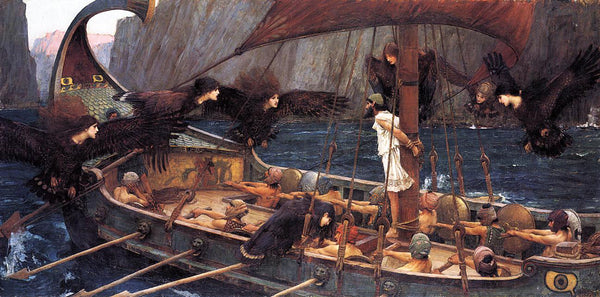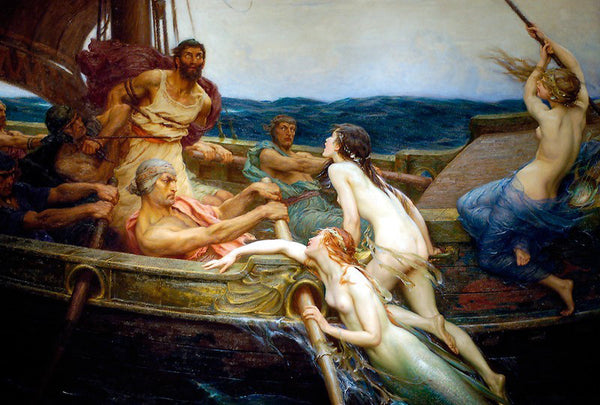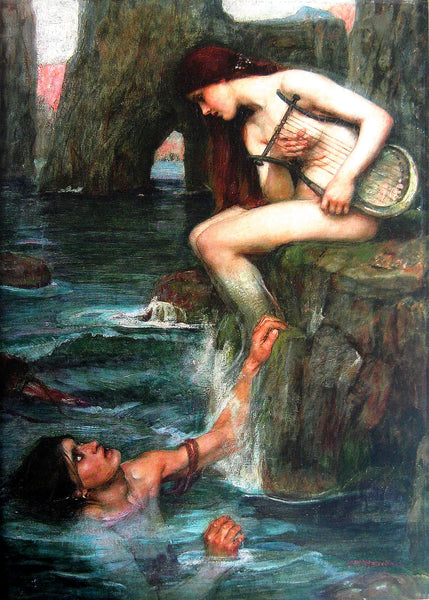News
Siren Spotlight: on the nature of sirens April 27, 2017 10:57
Today's blog contains images of nudity in the form of classical paintings.From Jess:
"Rescue Sirens" went from a vague idea about maybe developing something with lifeguard mermaids to a book series and an entire world when I was standing in my living room one day and heard the wailing of a rescue vehicle from the fire station down the street. "Rescue Sirens," I thought. "That's what you'd call lifeguard mermaids!"
I love terrible puns and wordplay, so I laughed at my own dorky joke... and then I couldn't get it out of my head. That's when questions began bubbling to the surface. What if these mermaids worked as lifeguards because they were sworn to an ancient vow to protect humans? What if living topside for a time was a requirement for all mermaids as soon as they came of age? What if they had to keep their identities a secret from the humans they lived amongst? I was intrigued and delighted by the possibilities. The more I thought about it, the more things fit together; the more it started to sound like a world.
As a fan of mythology, I was well aware that the classical Sirens were originally depicted as bird-women, but I also knew that the definition of the term had broadened over the centuries to include fish-women -- in other words, mermaids. I thought that this was universally accepted.
Boy, was I wrong!
While most people don't take issue with the concept of the word "siren" being a synonym for "mermaid" (or even give it a second thought), there's a vocal minority who objects to the very title of our series. A few weeks back, I ran an ad on Instagram, which exposed "Rescue Sirens" to a wider audience than usual... with some surprising results. I've chosen my favorite responses, presented here without comment:





Whew!
There are two main issues here: that sirens are bird-women, not mermaids; and that sirens are seductive, evil, and bloodthirsty. I'll address each separately.
#1. "Sirens are bird-women, not mermaids!"
I totally understand wanting to set the record straight when you feel that something's inaccurate. As a tiny bespectacled know-it-all child, I would vehemently correct anyone who used the term "killer whale," insisting, "NO, they're not killer whales, they're orcas, because they're actually the largest species of dolphin" -- but it's not always that simple.
As I later learned, the animal known as Orcinus orca was originally referred to by sailors as "whale killer" for its habit of hunting baleen whales, but the word order was switched over time to "killer whale," which is still in use today. (And yes, while orcas are classified as dolphins, all dolphins are also technically toothed whales, so they are whales in the more general sense. Mini-Jess was just being pedantic.) Language is a living thing, as fluid as the waters in which our Rescue Sirens swim, and things change.
Similarly, the definition for the word "siren" has expanded to include not only the bird-women of Ancient Greece, but also the mythological fish-women that we recognize as mermaids. How the heck did that happen? Some people point to the Catholic Church, which depicted seductive sirens as women with sinuous lower bodies like that of snakes or fish -- often the double-tailed version that you've seen on your Starbucks coffee cup -- out of a desire to avoid confusing sirens with Heaven's winged angels. Still others blame an error in translation. Whatever the reasons, referring to mermaids as "sirens" stuck.
Bird-women...

"Ulysses and the Sirens," John William Waterhouse (1891)
...and mermaids:

"Ulysses and the Sirens," Herbert James Draper (1909)
Pre-Raphaelite painter John William Waterhouse, who, in 1891, painted the Sirens tormenting Ulysses in their bird-women forms as you see above, produced the following image of a fish-legged Siren perched at the water's edge about a decade later:

"The Siren," John William Waterhouse (1900)
It's not just artists who began choosing the mermaid-siren over the bird-siren. Modern examples (besides "Rescue Sirens," that is!) include Disney's film "Pirates of the Caribbean: On Stranger Tides," with its mermaid character, Syrena; and the upcoming Freeform television series "Siren," which is about -- you guessed it -- a mermaid.
Even more compellingly, the word for "mermaid" in both Spanish and Italian is "sirena," while the French word is "sirène."
And, with my background in marine mammal husbandry, I'd be remiss in failing to mention the manatee and the dugong, the humble sea cows that are thought by many to be the biological inspiration for mermaid myths. The name of their scientific order? Sirenia.
Although the word "siren" may have initially referred to mythical women with bird features, today, it is also synonymous with "mermaid," which is why our lifeguard mermaid series is called "Rescue Sirens."
(Besides, "Rescue Mermaids" just sounds silly.)
#2. "Sirens don't help humans; they lure sailors to their deaths!"
This one's pretty straightforward. No illustrations needed!
The classical Sirens were originally depicted as seductive and deadly. We aren't playing by those rules, however; we've created our own distinctive twist. In "Rescue Sirens"' unique mythology, all humans originated from mermaids who stayed dry in their two-legged form too long, losing their ability to transform back and live in the sea -- so the remaining mermaids swore a solemn vow to forever watch over their landlocked kin. When a mermaid comes of age, she goes to live topside, pledged to protect, learn, and teach; it's at this time that she earns the rank of "Rescue Siren."
Insisting that all sirens are "supposed" to be deadly is like insisting that all ghosts are "supposed" to be scary, including the titular character in "Casper the Friendly Ghost." The distinction is right there in the title: the word "rescue" in "Rescue Sirens" lets you know that, if you're under the impression that sirens are inherently evil, these ones are different.
If this Siren Spotlight has demonstrated anything, it's that the evolution of language is absolutely fascinating!
We're not here to define the word "siren" for everyone; we're simply defining how we use it in our book series, based on one popular interpretation of a fantasy term: in "Rescue Sirens," the words "siren" and "mermaid" are used interchangeably to refer to the same creature (the way cougars are also known as panthers, pumas, mountain lions, or catamounts), and our Rescue Sirens are not hostile toward humans.
Outside of the "Rescue Sirens" property, though, we recognize and respect that other people's preferences and opinions differ. That diversity is part of what makes mermaid stories so much fun!
Siren Spotlight: biological atavism December 1, 2015 06:00
From Jess:
The first book in the "Rescue Sirens" series is subtitled "The Search for the Atavist"... but what is an Atavist, anyway?
According to our unique mermaid mythology, merfolk existed before human beings — in fact, they represent our species' very origin. From the beginning of time, mermaids and mermen were able to "make legs" indistinguishable from our own and walk around on shore, where they bred, gave birth in special birthing coves, and simply explored the vast expanses of wild land.
There was a catch, though (isn't there always?): after more than a day away from the ocean, legged merfolk would start to feel ill, and if they went for three full days without "turning tail" and submerging in water from head to fin-tip, their specialized lungs would dry up and they would lose their ability to change from legs to tail. Forever.
In other words, they became human.
Across the globe, merfolk were trapped on land often enough — due to losing their way, natural disasters, illness or injury, and even treachery — that the resulting small bands of human beings were able to sustain and eventually grow their population (although the offspring of human/human pairings lacked from birth the capacities to "turn tail" and breathe underwater). These humans were watched over when they went near the water by the mermaids and mermen still living in the ocean, and merfolk observe that ancient vow to protect their landbound brethren to this day; that's the role of a Rescue Siren.
But sometimes, once in a very long while, a human being is born with the ability locked within them to change their legs into a tail (and back again) as well as to breathe water, just like humankind's merfolk ancestors. This genetic throwback is known amongst merfolk as an Atavist.
The concept might sound like fantasy, but it has its roots in science. Courtesy of Dictionary.com, an atavism is defined as follows:
Since humans came from merfolk, the lower body's ability to metamorphosize between a legged and tailed form as well as the specialized lungs that allow breathing above and below water are biological atavisms. If the genes governing those features get "switched on" in the womb, that person will have the potential to regain the traits of his or her merfolk ancestors. (Successfully activating those traits if they're present is another matter entirely, however; you'll have to read the book to find out how that happens!)
Some of the most compelling examples of a biological atavism come from the sea, as well, but in reverse: wild whales and dolphins have been photographed with floppy little vestigial legs! Because cetaceans' origins are thought to lie in land-dwelling creatures like Pakicetus, today’s whales and dolphins still retain small bones in their lower bodies that resemble a reduced pelvic bone and hind limbs. Most of the time, these limb structures remain internal, but, when the genetic switch for longer legs gets flipped to the "on" position, you get—well, this:

Read the "National Geographic" article from 2006.
Crazy, right? I hope the other dolphins don’t make fun of them.
In addition to dolphins with hind legs like the one pictured above, scientists have also recorded cases of snakes with limbs and chickens with teeth, hearkening back to these animals' earlier forms as they existed millions of years ago.
You may even have heard about (or read — I haven't, yet) paleontologist Jack Horner's 2009 book, "How to Build a Dinosaur: The New Science of Reverse Evolution," in which he "predicted that scientists would someday be able to turn chickens into dinosaur-like forms" ("Reverse Engineering Birds' Beaks into Dinosaur Bones," NYTimes.com, 2015). That would involve "switching on" the genes that code for teeth and long tails, which the humble chicken possesses as relics passed down from its dinosaurian ancestors. It's an attempt at turning back the evolutionary clock that might yield very... interesting... results.

Source: LiveScience
So, there you have it: the answer to the question "What is an Atavist?" In "Rescue Sirens"' lore, the Atavist is a genetic throwback — a human with his or her "mer-gene" turned on — in the same vein as other biological atavisms, like dolphins with wee squiggly legs or hens with teeth. Oh, I love science.
Siren Spotlight: Caribbean monk seal September 29, 2015 18:33
From Jess:
When I first began developing "Rescue Sirens," I wanted our mermaids to be examples of convergent evolution: the phenomenon by which organisms of unrelated lineages show similar adaptations due to comparable environmental influences. In other words, animals that occupy the same biological niche share the same types of features because they're doing the same kind of things.
Since the mermaids in "Rescue Sirens" live in the waters around South Florida, most of them have lower bodies that resemble marine life native to that area (Nim being the sole exception, with her fantastical "classic" mermaid tail). Tiger sharks (Kelby), common dolphins (Maris), and blue marlins (Echo) are pretty obvious choices for South Florida sea creatures, but the one tail that regularly throws people for a loop is Pippa's, which looks like a seal tail.

Pippa, drawn by Chris Sanders and colored by Edgar Delgado.
Most people we've talked to assume Pippa's tail is supposed to be a harbor seal's. "Since when do harbor seals live off the coast of Miami?", we've been asked.
With the exception of the occasional wayward individual (like "Sunny," a young harbor seal rescued in New Smyrna Beach, Florida back in 2004), East Coast harbor seals like to stick around the chilly North Atlantic; you may see them as far south as North Carolina, but they're not adapted to warmer waters. A harbor seal wouldn't do well in Miami Beach.
But Pippa's tail is not modeled after a harbor seal. Her environmental inspiration is the Caribbean monk seal.

A captive Caribbean monk seal in the New York Aquarium, 1910. Photo courtesy of the US Fish & Wildlife Service.
Not much is known about the Caribbean monk seal. In fact, this species of seal hasn't been seen since 1952, when a small colony was sighted on the Seranilla Bank between Honduras and Jamaica. Despite that, the species was listed as "endangered" until 2008, when the National Oceanic and Atmospheric Adminstration's National Marine Fisheries Service (NMFS) completed a five-year status review and determined the Caribbean monk seal to be extinct.
Caribbean monk seals used to inhabit the waters of the Caribbean Sea, the western Atlantic Ocean, and the Gulf of Mexico; they hauled out on the sands of the Florida Keys and South Florida as well as Cuba and Jamaica, and they had breeding grounds in the Bahamas and Mexico. They are the only species of seal ever known to be native to the Gulf of Mexico and the Caribbean Sea.

The Caribbean monk seal's historic range. Map courtesy of NOAA's NMFS.
So what happened to the Caribbean monk seal? Their only predators were sharks -- and man. Christopher Columbus first described the Caribbean monk seal in 1494 and referred to them as "sea wolves." Upon discovering the animals resting on a beach, he had his crew kill eight of them immediately. Caribbean monk seals were docile and didn't flee from humans, making them exceptionally easy prey for fishermen, sailors, and whalers who wanted the seals' pelts, meat, and oil. According to the "Catalogue of the Specimens of Mammalia in the Collection of the British Museum," "as early as 1688, sugar plantations owners sent out hunting parties to kill hundreds of seals every night in order to obtain oil to lubricate the plantations' machinery." With that kind of mass slaughter taking place, the Caribbean monk seals' numbers had dwindled to the point that they could no longer be commercially hunted by 1850.
What probably finished off the Caribbean monk seal, though, was the decimation of their food source. Even the tiny remaining populations of Caribbean monk seals couldn't be supported by the tropical reefs where they fed due to constant overfishing by humans, and no real effort was made to protect the species. The Caribbean monk seal was placed on the Endangered Species List in 1967, fifteen years after the last reported sighting, so odds are good that it was already extinct.
Today, the Caribbean monk seal is survived by its relatives, the Hawaiian monk seal and the Mediterranean monk seal. However, both species are critically endangered; it's estimated that there about 1,100 Hawaiian monk seals alive in the wild, and only around 600 Mediterranean monk seals. But there's potentially good news: according to Loren McClenachan and Andrew B. Cooper, who published a study on the historical population structure of the Caribbean monk seal, "although [Caribbean monk seal] colonies on the edge of the range were eliminated quickly, the persistence of those in the centre and on offshore atolls indicates that monk seals are resistant to moderate to intense levels of human disturbance, which suggests that proper protection has the potential to save the remaining Hawaiian and Mediterranean monk seal colonies from extinction."
Hunting thankfully isn't the problem today that it was for the Caribbean monk seal centuries ago, but modern monk seals must still deal with the effects of overfishing as well as habitat loss, pollution, and entanglement in marine debris, so they have a number of hurdles to overcome. But people can help. The Save Monk Seals Project at the University of California at Santa Cruz states that "over 20% of the remaining [Hawaiian] monk seal population is alive today due to scientists and volunteers working together," so people can make a difference.
While the Caribbean monk seal, the only seal species that ever swam and played around Miami, has been lost to us, it may not be too late for the remaining two species of monk seals to recover if we can learn lessons from the past.

Pippa and a monk seal friend, drawn by artist Giada Carboni (giadin-a.tumblr.com).
Further reading:
Caribbean Monk Seal: Gone But Not Forgotten - U.S. Fish and Wildlife Service
Caribbean Monk Seal (Monachus tropicalis) - Office of Protected Resources - NOAA Fisheries
